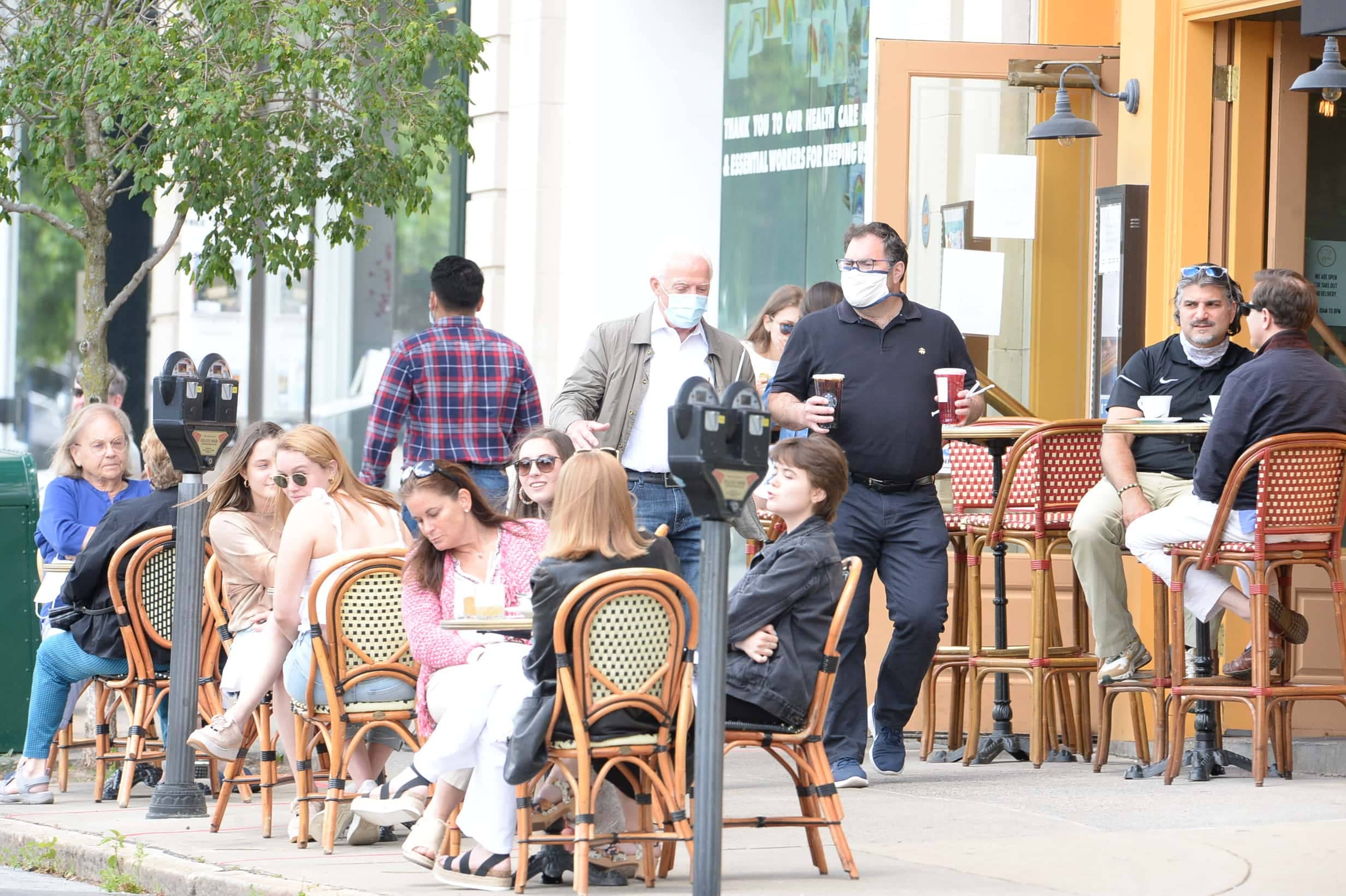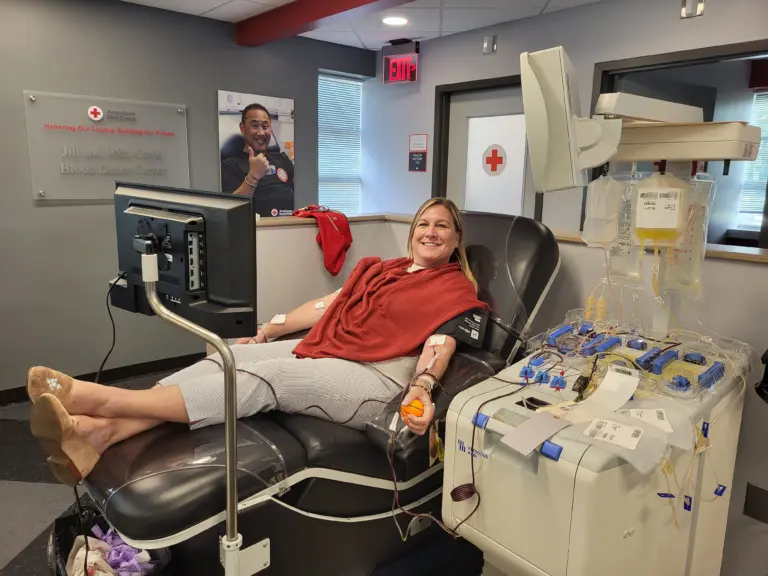

By Richard Kaufman
Sentinel Reporter
Originally intended to be a preventative measure to help businesses survive the COVID-19 pandemic, the partial closure and changes on Greenwich Avenue to make it more pedestrian friendly has in turn made the .65 mile stretch perhaps more vibrant than it’s ever been.
On Tuesday, the Board of Selectmen, along with other town and public safety officials, held a special meeting and public hearing to discuss Greenwich Avenue, parking, outdoor dining, and what the future could look like in the downtown area.
Joining the Board of Selectmen (First Selectman Fred Camillo, Selectpersons Lauren Rabin, Jill Oberlander) for Tuesday’s public hearing was Director of Planning and Zoning, Katie DeLuca; Greenwich Police Chief, James Heavey; Greenwich Fire Chief, Joseph McHugh; and GFD Fire Marshal, Chris Pratico.
Camillo noted that people he’s interviewed for boards and commissions have been impressed with the new look and feel of the downtown area.
“It’s very vibrant downtown, and it’s something we’ve all pledged to make permanent, whether it’s April to December, or whatever else the merchants and restaurant owners like,” he said.
Initially, the bottom two blocks of the Avenue were closed to traffic, and bump-outs (extended curbs) were installed at intersections, and parking “nodes” were put into place. After complaints from several retailers in the lower portion of the Avenue about lack of business, traffic and parking, the plan was modified in June and the closure encompassed just the lower block.
Several residents and business owners spoke during the 90 minute hearing, and the majority said they liked what’s being done on the Avenue. However, a few want some adjustments made.
“As always, we’re ready to adjust policies,” Camillo said. “We’ll certainly do our best to make it work for everybody. We don’t want it to work just for 75% of people, we want it to work for everybody.”
The panel spoke briefly before the public weighed in.
Heavey said a police presence on the Avenue will be looked at in the future, and some traffic studies have been done to see what options are available. Over the summer, officers were patrolling the Avenue on foot and bicycle.
Heavey and McHugh both said they were concerned about emergency vehicles navigating the bump-outs safely if they were to remain.
Last week, the BOS received a presentation on a project that would enhance the intersection at Elm Street and Greenwich Avenue with bump-outs and a raised intersection, to enhance pedestrian safety and decrease crossing times. The Department of Public Works said the project would be used as a “proof of concept” for other intersections in the downtown area.
Camillo said the bump-outs are designed with emergency vehicles in mind.
“Our whole goal is to make Greenwich a lot more attractive. We do want to have a more aesthetically pleasing avenue with the bump-outs. It’s also going to enhance public safety and sightlines. We want to make it as permanent a part of Greenwich Avenue as possible. I’ve been here my whole life, and I’ve never seen it as vibrant,” Camillo added.
McHugh also said he was concerned about the narrowing of lanes due to snow accumulation.
Pratico raised the concern about possibly dining in winter months inside tents. The fire department has had a lot of restaurateurs inquire about using portable heaters, but there are safety concerns and many regulations that need to be followed.
“I don’t see how the extension [of outdoor dining] is going to work,” he said.
Gov. Ned Lamont’s Executive Orders on outdoor dining are set to expire on Nov. 9, but they’re expected to be extended several more months. Without the Governor’s EO’s, outdoor dining falls under the jurisdiction of the Planning and Zoning Commission. If there is no extension, another public hearing could take place at P&Z’s next meeting on Nov. 5.
Meredith Bach, who works for Rand Insurance and is the president of the Chamber of Commerce in New Canaan, said people are not going to want to eat outside when it’s cold. She said New Canaan is encouraging restaurants to invest in air quality systems so indoor dining can be successful. She also said Darien and New Canaan have done a good job of rallying their communities to support restaurants with takeout orders.
Mary Hull from Greenwich Green & Clean suggested opening up one lane of traffic from the top of the Avenue to the bottom. She noted that seniors and handicapped people are not able to be dropped off, walk down to a restaurant or store, and then back up.
“If it’s humanly possible to get one lane of traffic all the way from the top of the avenue down to the bottom with the use of barriers, I think that would help both the stores and the restaurants,” she said.
Camillo said that option will be considered, but the safety of diners on or near the street will have to be addressed, and parking “nodes” would have to be taken into account.
Planning & Zoning Commissioner, Peter Levy, said other towns have come up with innovative ways to create access for people. He suggested the use of mountable curbs to allow for better separation between vehicles and pedestrians, and warming mats for outdoor diners.
Jim Michel, Deputy Commissioner of Greenwich DPW, said the curbs could present some safety concerns and would need to be looked at more carefully.
Margo O’Brien, daughter of Diane Garrett who owns Diane’s Books on Grigg Street just off the Avenue, said the original closure of Grigg Street led to a 40% drop in revenue. The modifications to reopen Grigg in June helped, but another closure in the area would be “untenable” since Diane’s Books makes about 30% of its revenue in November and December.
“If the Avenue is closed and people cannot park and get to our store, we will cease to exist,” O’Brien said, noting that she believes the bump-outs are a good idea. “I think my mother’s store is unique, and it’s what makes Greenwich special. My mother is 81, and she wants to do this until she’s 90. She’s fighting tooth and nail and making it work.”
John Stewart, who lives on the closed portion of Greenwich Avenue, said access to his building has been difficult, especially since he owns an online business and has to carry items up and down from his apartment frequently. He can’t pull his car up to his building.
“I’m a fan of making it work, but there’s been no remedy as far as our ability to access our building or move the barrier,” he said.
Resident Marianne Hillmer suggested proposing a downtown residential parking permit, and opening up parking at Town Hall. Camillo said he’d speak with Parking Services this week.
Michael Papa, owner of Michaelangelo at 410 Greenwich Ave., has been in business for 41 years, and said last year was his best. But the closure of the Avenue has negatively impacted him.
“No customers have been able to access us, our seniors are not able to move to us, customers are not coming,” he said, adding that several stores near him have already closed and left town. “We’re not asking you to open the street, we’re not asking you to take away from the restaurants. But we’d like the bump-outs so our customers can access the street, and we ask for 15 minute parking spots… We need your help.”
Resident Dan Quigley said he and his family have enjoyed the revitalized Avenue. He stressed that the area is a “work in progress.”
“It has a very European communal feel to it, which I think enhances the town. I know there are some issues,” he said. “Where you have a street closure now, you might have nodes that will allow for some parking for people who need to go to certain businesses. I think this work in progress will just keep going until it’s toned down to work for everyone.”
Camillo said that all comments and suggestions will be taken into consideration as the town tries to figure out how to proceed with the downtown area in the future. Selectperson Oberlander said public outreach is going to be critical.
“I think it’s critically important we have a full and open dialogue at this point in time. We have several months now to evaluate how effective this change has been, not just in aesthetics but in people’s experience and operation. In order to do that, we need a full and open dialogue, the good and the bad. This affects residents throughout town and the look of the town as a whole,” she said.




